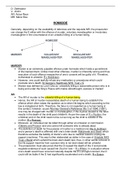Summary
Summary First Class Criminal Law Note: Homicide (Murder, Voluntary and Involuntary Manslaughter)
The document comprises of information from few academic books including the recommended book for UOL law students studying the module Criminal Law (LA1010). I have received a first class for this module.
[Show more]





